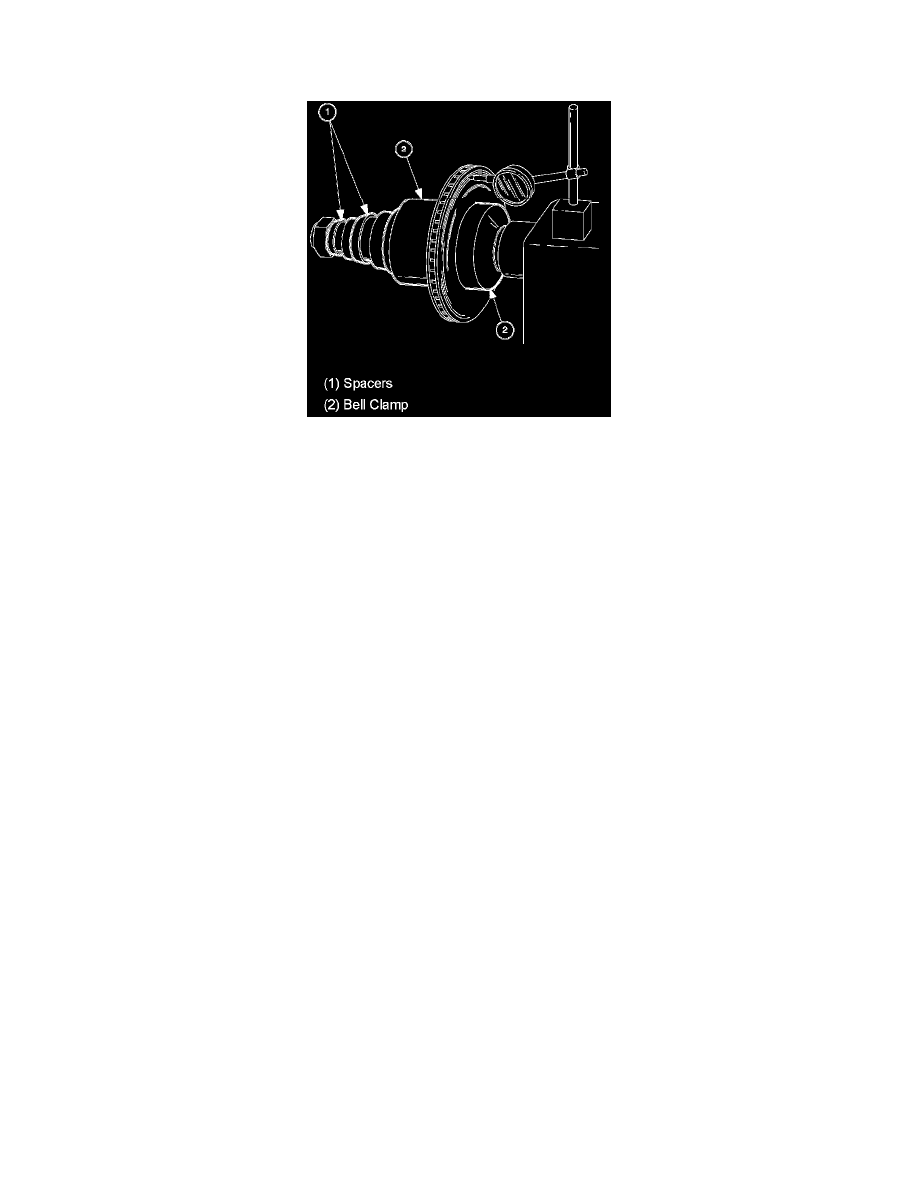SL L4-1.9L SOHC VIN 9 (1991)

rotor, but actually they may be too large, forcing the brake rotor to "wobble" when it turns on the lathe. (Bell clamp outside diameter ("D) must be
less than 139 mm [5.47 in.]). If a brake rotor does not turn on a plane that is parallel to the brake lathe's cutting tip, lateral runout will be machined
into the brake rotor.
3.
Both surfaces of the inside bell clamp must be parallel or the brake rotor will not turn on a parallel plane with the cutting tip. If a bell clamp is
dropped or damaged, contact the brake lathe's manufacturer to obtain a new bell clamp.
4.
Use the largest possible spacers to hold the bell clamps on the lathe's spindle. This will ensure that the most weight possible is on the spindle,
helping the brake rotor to turn on a plane parallel to the brake lathe's cutting tip.
5.
Before machining, use a magnetic dial indicator to make sure that the brake rotor turns squarely on the brake lathe. Attach dial indicator on lathe
and check brake rotor runout. Mark highest point of lateral runout on the brake rotor. Loosen attachment hardware and rotate brake rotor 180° (1/2
turn) while holding the inside bell clamp in its original position. Tighten attachment hardware and recheck brake rotor runout. Any runout must
follow the brake rotor. That is, the already marked high spot on the brake rotor must remain the high spot. If not, some problem exists in the
attachment of the brake rotor on the lathe, such as bent bell clamps, incorrect bell clamps, or untrue mounting surfaces.
6.
After turning the brake rotor, visually check the machined brake rotor's surface finish. Any deterioration in the machined surface finish quality of
the brake rotor usually indicates worn cutting tips. Always use the cutting tips recommended by the brake lathe's manufacturer.
7.
A secondary finishing operation improves brake rotor surface finish. Saturn recommends using silicon carbide 150 grit emery paper mounted on a
sanding block. Using moderate pressure, hold the paper against the brake rotor for 90 seconds per side as it turns in the lathe.
8.
Thoroughly clean machined brake rotors with a spray solvent such as Saturn Choke Cleaner (P/N 21007127 [in Canada, P/N 88900260]) or Saturn
Brake and Choke Cleaner (P/N 21007432 [in Canada, P/N 88901247]) or equivalent.
Information on Performing Brake Service
Several important factors are frequently overlooked when performing brake service. The following list must be considered and followed when
appropriate:
1.
Proper machining of brake rotors is not a simple operation. Make sure the brake lathe is well maintained. Keep it clean at all times. Handle
attachment hardware with care. Damaged hardware will not machine brake drums or brake rotors accurately. Inspect the surface finish of
machined brake rotors and brake drums to make sure the cutting tips are in good condition. Make sure the cutting tips remain in good condition.
Use a dial indicator to make sure brake rotors turn squarely on the brake lathe. (Refer to step 5 under the "Recommended Procedure for Machining
Brake Rotors" in this bulletin.)
2.
Keep all installed brake parts as clean as possible. Make sure to clean machined brake rotors and brake drums with a spray solvent (Saturn Choke
Cleaner P/N 21007127 [in Canada, P/N 88900260] or Saturn Brake and Choke Cleaner P/N 21007432 [in Canada, P/N 88901247] or equivalent).
Always wipe off machined brake rotor surfaces with a lint tree shop towel after cleaning.
3.
Thickness variation of brake rotors due to wear is a major cause of brake pulsation. Using a micrometer, check for excessive thickness variation
whenever a customer comments on brake pulsation.
4.
Lateral brake rotor runout and restricted pads together are the leading cause of uneven brake rotor wear. Therefore, this combination leads directly
to brake pulsation.
